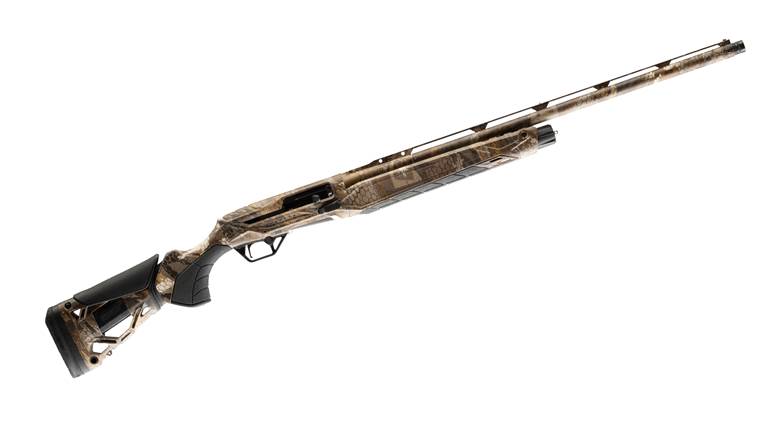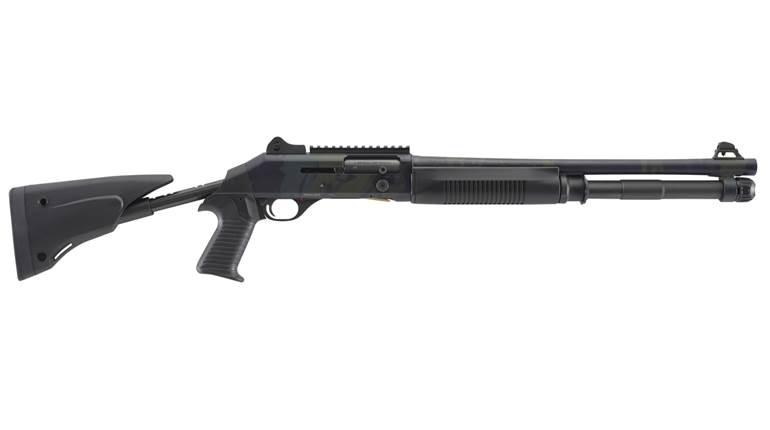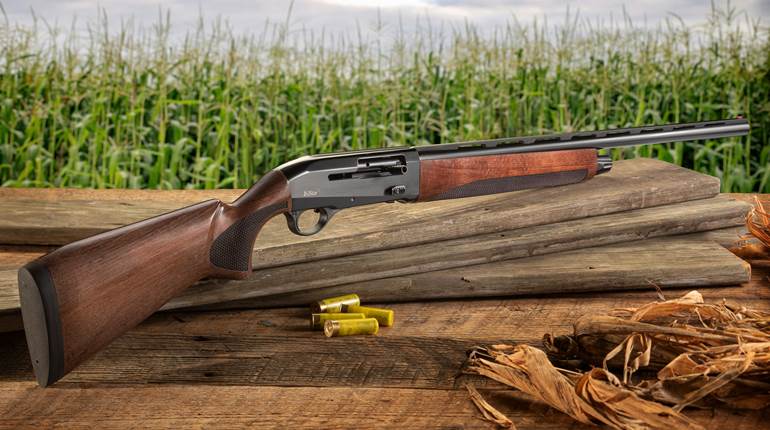
The Great War was notable for the carnage that resulted when 19th-century military tactics were pitted against 20th-century infantry arms—such as machine guns, poison gas and flame throwers—which were used by all belligerent nations. There was, however, one infantry arm employed in the war that was uniquely American: the shotgun.
Although shotguns had been used by individuals in the U.S. military for over 100 years, the guns were generally privately owned arms. After the Civil War, a few shotguns were again employed during the so-called “Indian Wars.” The U.S. Army procured a relatively small number of shotguns for “foraging” use, but some privately owned shotguns also saw action during that period. The use of shotguns for deadly serious purposes was well-ingrained in the American psyche as aptly related in a 1920s article published in Harper’s Pictorial:

“... [The shotgun] is not a new man-killing arrangement. For years, the sawed-off shotgun has been the favorite weapon of the American really out gunning for the other fellow or expecting the other fellow to come a-gunning for him.”
Despite the well-known effectiveness of shotguns for certain situations, the first procurement of shotguns specifically for combat use by the U.S. military did not occur until the dawn of the 20th century. Circa 1900, the U.S. Army purchased an estimated 200 Winchester Model of 1897 slide- action repeating shotguns for use in the on-going “pacification” campaigns in the Philippine Islands following the Spanish-American War of 1898.

There was a clear need for an arm to help battle the fierce Moro tribesmen, who were exacting a deadly toll on American troops in close-quarters combat. It was recognized that a short-barreled, 12-ga. shotgun loaded with 00 buckshot was the most formidable tool available for such applications. These “sawed off” shotguns soon proved their mettle and were used with notable effectiveness in the Philippines.
When the United States entered World War I in the spring of 1917, General John Pershing and the U.S. Army General Staff were determined not to repeat the same mistakes that were made by both sides during the previous three years of the war. As stated in an American Rifleman article published after the war:

“When the A.E.F. began to take over portions of the front lines it brought with it General Pershing’s predetermined decision to break up the enemy’s use of its trenches as take-off points for such assaults, to destroy such attacking ‘shock troops’ as they came on, and so to compel the open-ground warfare for which Europeans had little liking but which was wholly in the character of the American spirit and in which it was foreseen the latter would give an extremely effective account of themselves.”
The new tactics that were to be employed by the American “Doughboys” required new arms. Many of the senior officers of the American Expeditionary Force (AEF), including Gen. Pershing, had previously served in the Philippines and had first-hand knowledge of the effectiveness of the shotgun. It was soon recognized that they possessed much potential for both offensive and defensive trench warfare.
The U.S. Army Ordnance Department was ordered to evaluate which shotgun would best suit the needs of the American troops deploying to France. The consensus was that the Winchester Model 1897 would be the logical choice. The Model 1897, later designated the “M97,” was a reliable gun that had been around for some 20 years and had acquitted itself well in the Philippines.

The variant of the Model 1897 selected by the Ordnance Department had a solid frame (non-takedown) with a riot-length (20”) cylinder bore barrel. The gun had a total capacity of six rounds (five in the magazine and one in the chamber) and lacked a disconnector. This meant that it could be fired by holding down the trigger while rapidly manipulating the slide, which resulted in a high rate of fire when used in that manner.
While a 20”-barreled Model 1897 shotgun could be obtained literally “off the shelf” from Winchester, the Ordnance Department stipulated that the new combat shotgun must be capable of mounting a bayonet. Although that may appear to have been a simple requirement, it posed some vexing problems. While the typical rifle barrel was small enough in diameter to permit it to fit inside a bayonet guard ring, the large diameter of a 12-ga. shotgun’s bore precluded that method of attachment. The problem was solved by the use of an offset bracket attached to the end of the barrel for attachment of the bayonet.

Another problem to overcome was the fact that a shotgun’s barrel would become extremely hot after firing only a few rounds. Since it would be impossible to effectively wield a bayonet without being able to firmly grasp the barrel, some form of protection was required. A ventilated metal handguard was designed that allowed air circulation between the guard and barrel and permitted a bare hand to control a hot barrel. Springfield Armory worked in conjunction with Winchester on the design of a handguard/bayonet adapter assembly. In a relatively short period of time, the proposed new combat shotgun was officially adopted.
The new arm, soon dubbed the “trench gun,” was given the ordnance code designation number “G-9778-S.” The guns were typically hand-stamped with a “US” and “flaming bomb” marking on the right sides of the receivers in front of the ejection ports to signify acceptance by the U.S. Army Ordnance Department.

The new “trench gun” was designed to be used with the M1917 “U.S. Enfield” rifle bayonet, presumably because there were larger numbers on hand as compared to the M1905 bayonet used with the M1903 Springfield rifle. The fact that Winchester was also making the M1917 bayonet at that time may also have played a role in its selection. The new trench gun was fitted with sling swivels that permitted the use of standard service rifle slings, primarily the leather M1907 sling. The guns were initially issued with commercial-production paper-case 00 buckshot ammunition.
As shotguns were not previously in the Army’s Tables of Organization and Equipment (TO&E), limited numbers were issued to selected infantry units in France for preliminary field testing and evaluation. An Ordnance Department memo dated June 8, 1918, stated:
“… 1,000 shotguns, referred to herewith, together with ammunition are now available in Depots in France … . Instructions are requested regarding the issue and distribution of these weapons. It is suggested that they may prove a most valuable arm for the use of raiding parties, and that a practical test be made in the 26th and 42nd Divisions, and that full information be furnished this office within 30 days, showing the difficulties experienced in maintenance, the susceptibility to jam under trench conditions, and the effectiveness of the weapon. Fifty guns should be issued to each Division mentioned above, with 100 rounds of ammunition per gun … .”

Other divisions that were issued trench guns during the war included the 5th, 26th, 32nd, 35th, 42nd, 77th and 82nd. Most of the reports from the units that were issued trench guns for preliminary testing were positive in nature. Typical responses included: “It is the general opinion of those who have used shotguns that they are effective weapons for scouting and patrolling purposes. Col. H.J. Hunt, Sixth Infantry,” and “Shotguns in this regiment have given very satisfactory results. Their effectiveness at short ranges, on raids and patrols makes them a most desirable weapon, and I would recommend that they be adopted. Captain H.P. Blanks, 61st Infantry.”
The most common complaints against shotguns pertained to the propensity of the paper-cased ammunition to become wet in the muddy trench environment, which could cause the shells to swell and become unusable. The lack of belts or pouches to carry the shells was also cited as a problem in several reports. This was discussed in a post-World War I American Rifleman article:
“[I]n the trenches the cartons (of shotgun shells) were set on the long shelf under the parapet … and the doughboys would put a couple of handfuls in their breeches pockets, just as they were accustomed to ‘at home on the farm.’”

Canvas looped shotshell belts were considered for use with the guns but were not the optimum method of carrying shotgun shells in the constantly damp and muddy trenches. A canvas pouch with internal loops (holding 32 rounds) and a shoulder sling was designed and procured to carry trench gun ammunition, but few were likely sent overseas before the Armistice.
Since the major culprit was the paper-cased shells, all-brass 00 buckshot ammunition was ordered. Such ammunition would be less susceptible to moisture and could better withstand the battering from constant loading and unloading of the guns. Some of the all-brass buckshot ammunition of that era was characterized by an unusual “saw tooth” crimp.
U.S. Ordnance Department records indicate that Winchester delivered 19,196 Model 1897 trench guns to the government during the First World War. It is likely that several thousand more guns were procured from wholesalers and jobbers for conversion to trench guns during that period, and, perhaps, as many as 25,000 M1897 trench guns were eventually manufactured during the war. World War I Winchester Model 1897 trench guns were serially numbered in three “blocks”: E433144-E474130; E514382-E566857; and E613303-E697066.

These blocks were obtained from ordnance documents and reports, and some slight variance on either side of the ranges may be expected. Most of World War I M1897 trench guns were in the third block of serial numbers.
In order to augment the supply of combat shotguns, the Ordnance Department contracted with the Remington Arms Co. for a trench gun variant of its Model 10 12-ga. shotgun. The Model 10 was a hammerless slide-action repeater that loaded and ejected from a port in the bottom of the receiver. Rather than utilizing the metal handguard/bayonet adapter assembly of the Winchester Model 1897 trench gun, the Remington Model 10 trench gun was designed with a metal bayonet adapter that clamped on the end of the barrel and a separate wooden handguard. The Model 10 adapter was also designed for use with the M1917 bayonet, which was also manufactured by Remington during that period.
The Model 10 trench gun had a 231⁄2” barrel and was fitted with sling swivels. The guns were stamped with a “US” and “flaming bomb” insignia on the left sides of the receivers. Remington delivered 3,500 Model 10 trench guns to the government during World War I. The serial number range of World War I military Model 10 trench guns was 128000-166000. Again, this is an approximate range and some slight variance on either side is possible.

In addition to the trench guns, the Ordnance Department purchased a quantity of Winchester Model 1897 and Remington Model 10 “riot guns.” These differed from the trench guns in that they were not fitted with bayonet adapter/handguard assemblies and did not have sling swivels. While some combat use cannot be ruled out, the riot guns were primarily intended to be utilized for guarding prisoners and similar duties.
As increasing numbers of the trench guns began to be deployed to the front-line trenches, their effectiveness became apparent. There were numerous references to the efficiency of the shotguns.
A post-war American Rifleman article contained the following statement regarding a U.S. Army officer: “[H]is men had one good chance with them (shotguns) at a German mass assault upon his trench—a charge obviously intended to overwhelm the defenders with its solid rush of men. (They) let them come on; and when those shotguns got going—with nine .34 caliber buckshot per load, 6 loads in the gun, 200-odd men firing, plenty more shells at hand—the front ranks of the assault simply piled up on top of one awful heap of buckshot-drilled men.”

Laurence Stallings related the following in his classic book, The Doughboys: “[A] Chicago sergeant, undergoing much hostile fire to reach a concrete pillbox, made his entrance through the stage door of the pestiferous machine-gun nest bearing a sawed-off shotgun. Two buckshot blasts and the twenty-three performers left on their feet surrendered.”
The shotgun’s effectiveness did not go unnoticed by the German government, which viewed the use of shotguns as a serious breach of international rules of warfare and lodged an official protest on September 14, 1918. The Germans sent a telegram to U.S. Secretary of State Robert Lansing, which stated, in part: “The German Government protests against the use of shotguns by the American Army and calls attention to the fact that, according to the laws of war, every prisoner found to have in his possession such guns or ammunition belonging thereto forfeits his life.”
The Germans were referring to a passage in the Hague Decrees, predecessor of the Geneva Convention, which stated, “It is especially forbidden to employ arms, projections, or material calculated to cause unnecessary suffering.” The Kaiser’s minions also sought to exploit the issue for propaganda purposes, and several German newspapers wrote scathing editorials against this “barbaric” weapon.

For example, the Cologne Gazette opined that “… tommy-hawks and scalping knives would soon make their appearance on the American front … ,” and stated that “... Americans are not honorable warriors.” The Weser Zeitung newspaper was of the opinion that “… the barbarous shotguns have not been served out because they are likely to be effective but because the ill-trained Americans cannot use rifles and are badly supplied with machine guns.” It is reported that some of our Doughboys were rather amused by these editorial rants!
The United States government’s response to the German threat was swift and to the point. Secretary Lansing firmly replied that the use of shotguns was most assuredly not prohibited by the Hague Decrees or any other international treaty. He also made it known that if the Germans carried out their threats in even a “single instance” the American government knew what to do in the way of reprisals and stated that “notice is hereby given of the intention to make such reprisals.”
As correctly summed up in an American Rifleman article after the war: “Uncle Sam did not intend to have his trench-gunners massacred simply because he had given them a weapon which even the pick of the Prussian ‘shock troops’ dreaded more than anything that four years of war had called on them to face.”

Apparently, the American response had the desired effect as there is no indication that the Germans ever executed any Doughboys for possessing a shotgun or shotgun shells. It is perplexing as to why the Germans, who introduced and regularly used poison gas and flamethrowers, were so incensed about our use of shotguns. It is probable that the enemy actually feared the American behind the shotgun as much as the shotgun itself.
The United States considered the matter closed and continued to send trench guns to France as fast as production and shipping permitted. As stated in a publication after the war: “The shotguns went right on at their business—so terrible a success that message after message from G.H.Q. to America begged: ‘Give us more shotguns!’”
In addition to use in trench warfare and for guarding prisoners, some shotguns were reportedly employed in front-line positions in an attempt to deflect incoming German grenades. Some have questioned whether this actually occurred, but a number of World War I and post-World War I accounts confirm this practice.

A post-war American Rifleman article stated: “An interesting if amazing purpose which these guns (trench guns) were supposed to serve was that of shooting from the trenches, a la trapshooting, at hand-grenades, ‘potato mashers,’ and the like thrown over by the enemy, with a view to knocking such missiles back, to fall and explode outside the parapet. The procedure was taught and practiced at training camps during the war, using dummy Mills bombs as the aerial targets.”
Due to extensive use prior to World War II, original World War I Winchester and Remington trench guns are scarce today and are coveted by martial arms collectors. All World War I-era shotguns were originally blued, and any Parkerized examples have been refinished, possibly as part of a later arsenal overhaul.
A number of 1918 vintage M1897 trench guns may be encountered today without martial markings. The most logical explanation for such guns is that they were purchased by the government during World War I but the war ended before the guns could be issued, thus they were not stamped with the “US” and “flaming bomb” markings.
The popularity of shotguns is not restricted to collectors. Modern combat shotguns are in front-line use by American troops today—just as they were in the trenches of France more than 100 years ago. The shotgun is still a uniquely American combat arm. In certain combat applications, it is a fearsome arm with unquestioned effectiveness, just as the Kaiser’s troops first discovered in 1918 “in the trenches."





































